The AMD Threadripper 2990WX 32-Core and 2950X 16-Core Review
by Dr. Ian Cutress on August 13, 2018 9:00 AM ESTHEDT Benchmarks: Encoding Tests
With the rise of streaming, vlogs, and video content as a whole, encoding and transcoding tests are becoming ever more important. Not only are more home users and gamers needing to convert video files into something more manageable, for streaming or archival purposes, but the servers that manage the output also manage around data and log files with compression and decompression. Our encoding tasks are focused around these important scenarios, with input from the community for the best implementation of real-world testing.
Handbrake 1.1.0: Streaming and Archival Video Transcoding
A popular open source tool, Handbrake is the anything-to-anything video conversion software that a number of people use as a reference point. The danger is always on version numbers and optimization, for example the latest versions of the software can take advantage of AVX-512 and OpenCL to accelerate certain types of transcoding and algorithms. The version we use here is a pure CPU play, with common transcoding variations.
We have split Handbrake up into several tests, using a Logitech C920 1080p60 native webcam recording (essentially a streamer recording), and convert them into two types of streaming formats and one for archival. The output settings used are:
- 720p60 at 6000 kbps constant bit rate, fast setting, high profile
- 1080p60 at 3500 kbps constant bit rate, faster setting, main profile
- 1080p60 HEVC at 3500 kbps variable bit rate, fast setting, main profile
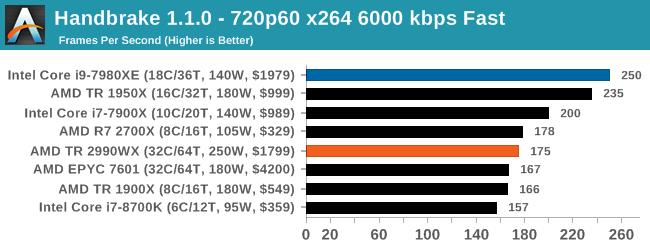
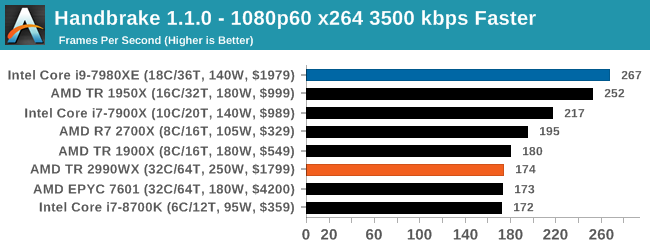
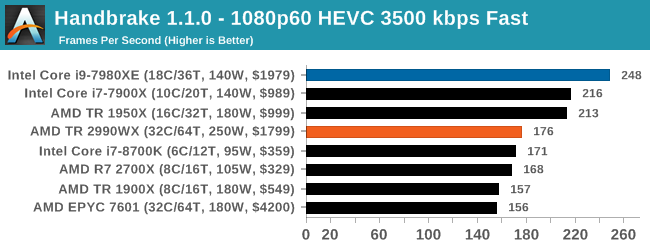
Video encoding is always an interesting mix of multi-threading, memory latency, and compute. The Core i9, with AVX2 instructions, sets a commanding lead in all three tests. The AMD processors seem to fluctuate a bit, with the 1950X and 2700X being the best of the bunch. Unfortunately we didn’t get 2950X results in our initial runs, but I would expect it to be competitive with the Core i9 for sure, given where the 1950X is. However the 2990WX does fall behind a bit.
7-zip v1805: Popular Open-Source Encoding Engine
Out of our compression/decompression tool tests, 7-zip is the most requested and comes with a built-in benchmark. For our test suite, we’ve pulled the latest version of the software and we run the benchmark from the command line, reporting the compression, decompression, and a combined score.
It is noted in this benchmark that the latest multi-die processors have very bi-modal performance between compression and decompression, performing well in one and badly in the other. There are also discussions around how the Windows Scheduler is implementing every thread. As we get more results, it will be interesting to see how this plays out.
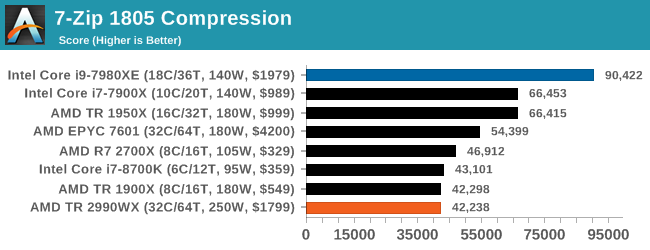
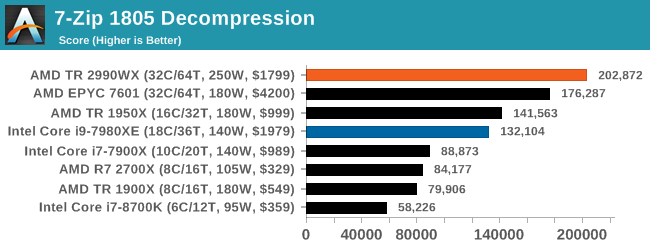
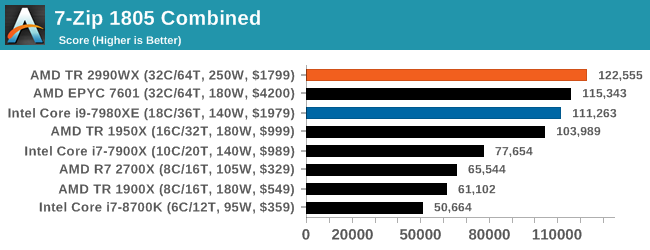
Oh boy, this was an interesting set of tests. When we initially published this review, without commentary, the compression graph with the 2990WX at the bottom was shared around social media like crazy, trying to paint a picture of why AMD performance isn’t great. It was also used in conjuction with Phoronix’s tests, that showed a much better picture on Linux.
But what confuses me is that almost no-one also posted the decompression graph. Here AMD’s 32-core processors take a commanding lead, with the 16/18-core parts being the best of the rest.
If you plan to share out the Compression graph, please include the Decompression one. Otherwise you’re only presenting half a picture.
WinRAR 5.60b3: Archiving Tool
My compression tool of choice is often WinRAR, having been one of the first tools a number of my generation used over two decades ago. The interface has not changed much, although the integration with Windows right click commands is always a plus. It has no in-built test, so we run a compression over a set directory containing over thirty 60-second video files and 2000 small web-based files at a normal compression rate.
WinRAR is variable threaded but also susceptible to caching, so in our test we run it 10 times and take the average of the last five, leaving the test purely for raw CPU compute performance.

A set of high frequency cores and good memory is usually beneficial, but sometimes some more memory bandwidth and lower latency helps. At the top is AMD’s R7 2700X, with the Intel 10-core just behind. I’m surprised not to see the 8700K in there, perhaps its six cores is not enough. But the higher core count AMD parts struggle to gain traction here, with the 32-core parts taking some sweet time to finish this test.
AES Encryption: File Security
A number of platforms, particularly mobile devices, are now offering encryption by default with file systems in order to protect the contents. Windows based devices have these options as well, often applied by BitLocker or third-party software. In our AES encryption test, we used the discontinued TrueCrypt for its built-in benchmark, which tests several encryption algorithms directly in memory.
The data we take for this test is the combined AES encrypt/decrypt performance, measured in gigabytes per second. The software does use AES commands for processors that offer hardware selection, however not AVX-512.
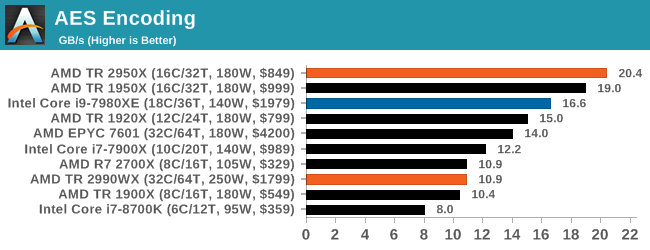
Normally we see this test go very well when there are plenty of cores, but it would seem that the bi-modal nature of the cores and memory controllers in the 2990WX gives a poor result. The EPYC 7601, with eight memory controllers, does a better job, however the 1950X wins here. The 2950X, where all cores have a similar access profile, scores top here, well above Intel’s 18-core Core i9.










171 Comments
View All Comments
NevynPA - Tuesday, August 14, 2018 - link
Will there be results for WX chips in 'Game Mode' at various core/thread counts (6/12,8/16,12/24)?jospoortvliet - Saturday, August 18, 2018 - link
It has no game mode. Don't bother buying it for games...jts888 - Tuesday, August 14, 2018 - link
What is the methodology used for the core/uncore power breakdown? Where was a physical measurement or software reading taken, and what were the loads used?Furthermore, Zen uses single-ended signaling for IF links with alleged even further reduced power draw when in transient no-send states, so there should be at least two clearly explained tests done (i.e., both high and low inter-thread/core/sock bandwidth, with NUMA allocations detailed) before interconnect power breakdowns can be credibly presented as flat metrics of the architectures investigated.
Although this review is still a work in progress, it needs some substantial improvements in clarity given the strength of the claims made and conclusions drawn.
ktmrc8 - Thursday, August 16, 2018 - link
Let me add my voice to those asking for further elaboration on this point. I think it's very interesting, but I would like enough detail so that I could possibly replicate your data. In particular, I the charts showing power consumption decreasing as number of loaded threads increase counter-intuitive (at least for me!). Thanks.Sahrin - Tuesday, August 14, 2018 - link
The link power is a problem, but I get the feeling that nowhere near the power optimization went into IF as went into the cores.notfeelingit - Tuesday, August 14, 2018 - link
What's up with the 2950X crazy low score for the PCMark10 Startup Test? Is that repeatable?crotach - Tuesday, August 14, 2018 - link
So, 2700X looks like a clear winner here?GreenReaper - Wednesday, August 15, 2018 - link
For the average consumer, yes. It's a sweet spot. Heck, most would do fine with an APU. You don't expect a truck to win a race. Small engines tend to be more efficient; they're just limited in raw power.witeko - Tuesday, August 14, 2018 - link
hi, can we have some tests regarding data processing (spark, dask), machine learning (lightGBM/xgboost training), deep learning (i know there are GPUs) just to get a feeling (there are pre-made benchmarks for tensorflow) ? And also some reviews point to win10 vs linux differences for example in the zip test.farmergann - Tuesday, August 14, 2018 - link
Really should have included the Epyc 7401p as it's a serious contender in this price range (only $1,000).